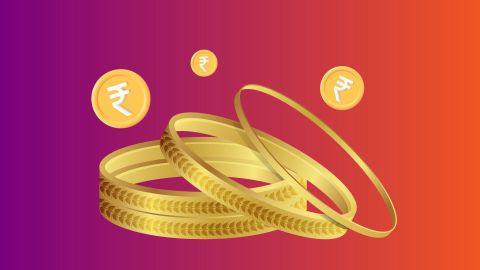2 mins
19 November 2024
Gold hedging is a financial strategy used to manage the risks associated with gold price fluctuations. It is widely used by investors, jewellers, and businesses dealing with gold to protect their investments or operational costs. By locking in future prices, gold hedging ensures stability and reduces exposure to market volatility. This guide explores gold hedging principles, strategies, and its importance in securing financial goals, helping Indian readers understand its role in managing risk effectively.
Principles of gold hedging
| Principle | Description |
| Risk Mitigation | Reduces exposure to gold price volatility by locking in future prices. |
| Price Locking | Ensures stability by fixing a gold price through futures, options, or swaps. |
| Hedging Ratio | Determines the percentage of exposure to be hedged, balancing risk and opportunity. |
| Counterparty Risk | Considers the reliability of financial institutions involved in hedging transactions. |
| Cost Management | Accounts for hedging costs, ensuring the strategy remains profitable over time. |
Why is gold hedging important?
Gold hedging is crucial for protecting financial interests against unpredictable market fluctuations. In India, where gold is an essential asset, hedging helps stabilise investments and business operations. For jewellers, it safeguards profitability by ensuring stable costs for raw materials. Investors benefit by locking in favourable prices, minimising potential losses during downturns. Additionally, hedging is essential for gold loans, enabling borrowers to mitigate risks associated with fluctuating gold rates. By securing stable pricing, gold hedging fosters financial security and long-term planning.How does gold hedging work?
Gold hedging works by using financial instruments to fix the future price of gold. A jeweller, for instance, may enter into a futures contract to purchase gold at a predetermined rate, protecting against potential price increases. Similarly, an investor can use options to secure a price floor, ensuring minimal losses if prices drop. Swaps allow businesses to exchange cash flows based on current and future gold rates. Bajaj Finance uses such mechanisms to ensure that gold-backed loans are adequately secured, safeguarding both parties against market volatility.Types of gold hedging strategies
Gold hedging strategies vary depending on the risk appetite and goals of the stakeholder. Below are some commonly used approaches:- Futures contracts: Agreements to buy or sell gold at a fixed price on a future date.
- Options contracts: Grants the right, but not the obligation, to buy or sell gold at a set price.
- Swaps: Agreements to exchange cash flows based on current and future gold prices.
- ETFs: Gold-backed exchange-traded funds to diversify portfolios and mitigate risk.
- Physical hedging: Maintaining gold reserves as a hedge against price fluctuations.
Pros and cons of gold hedging with gold loans
| Aspect | Pros | Cons |
| Risk Management | Protects borrowers against gold price drops during gold loan tenure. | Requires additional expertise to implement effectively. |
| Loan Value Stability | Ensures consistent loan amounts based on hedged gold prices. | May incur higher costs due to hedging fees. |
| Predictable Costs | Helps borrowers plan EMIs and repayments with price certainty. | Limited flexibility in adapting to rapid market changes. |
| Better Returns | Mitigates risk, allowing better utilisation of gold loan funds. | Counterparty risks if financial institutions fail to honour agreements. |
Examples of gold hedging
Gold hedging is widely practised in industries and investments. For instance, a jeweller in India may hedge gold prices using futures contracts to lock in raw material costs. An investor holding significant gold reserves might use options to protect against a sudden price drop. Similarly, Bajaj Finance can offer hedging-backed gold loans to ensure stable valuations for borrowers. Such practices demonstrate how businesses and individuals can effectively use gold hedging to reduce risks and maximise stability.Frequently asked questions
What is the hedging ability of gold?
Gold has a strong hedging ability due to its status as a stable store of value. It protects investors and businesses from financial risks like inflation, currency fluctuations, and economic instability. During market downturns, gold retains or increases its value, offering a safe haven for investments. This makes it an ideal hedge against unpredictable market conditions, ensuring financial stability and long-term security.
How do you buy gold as a hedge?
To buy gold as a hedge, you can invest in physical gold, such as coins or bars, or financial instruments like gold ETFs, futures, or options. Physical gold offers direct ownership, while ETFs and futures provide liquidity and ease of trading. It’s essential to monitor gold market trends and consult with trusted institutions like Bajaj Finance for secure investments tailored to your hedging needs.
Who benefits from hedging?
Hedging benefits investors, businesses, and jewellers who seek to manage risks related to price volatility and financial instability. For instance, businesses can lock in costs, while jewellers stabilise raw material expenses. Borrowers using gold loans also benefit, as hedging ensures stable valuations, reducing repayment risks. By providing financial certainty, hedging supports profitability and long-term planning for all stakeholders.
What is an example of gold hedging?
A jeweller might use a futures contract to lock in a gold price for future purchases, avoiding potential price increases. Similarly, an investor holding gold reserves can use options to secure a minimum price during market downturns. Such strategies protect against price volatility, ensuring stable costs or returns. For borrowers, hedged gold loans offer predictable loan amounts, demonstrating practical gold hedging applications.
Show More
Show Less
Bajaj Finserv App for All Your Financial Needs and Goals
Trusted by 50 million+ customers in India, Bajaj Finserv App is a one-stop solution for all your financial needs and goals.
You can use the Bajaj Finserv App to:
Apply for loans online, such as Instant Personal Loan, Home Loan, Business Loan, Gold Loan, and more.
You can use the Bajaj Finserv App to:
Apply for loans online, such as Instant Personal Loan, Home Loan, Business Loan, Gold Loan, and more.
- Explore and apply for co-branded credit cards online.
- Invest in fixed deposits and mutual funds on the app.
- Choose from multiple insurance for your health, motor and even pocket insurance, from various insurance providers.
- Pay and manage your bills and recharges using the BBPS platform. Use Bajaj Pay and Bajaj Wallet for quick and simple money transfers and transactions.
- Apply for Insta EMI Card and get a pre-approved limit on the app. Explore over 1 million products on the app that can be purchased from a partner store on Easy EMIs.
- Shop from over 100+ brand partners that offer a diverse range of products and services.
- Use specialised tools like EMI calculators, SIP Calculators
- Check your credit score, download loan statements, and even get quick customer support—all on the app.






